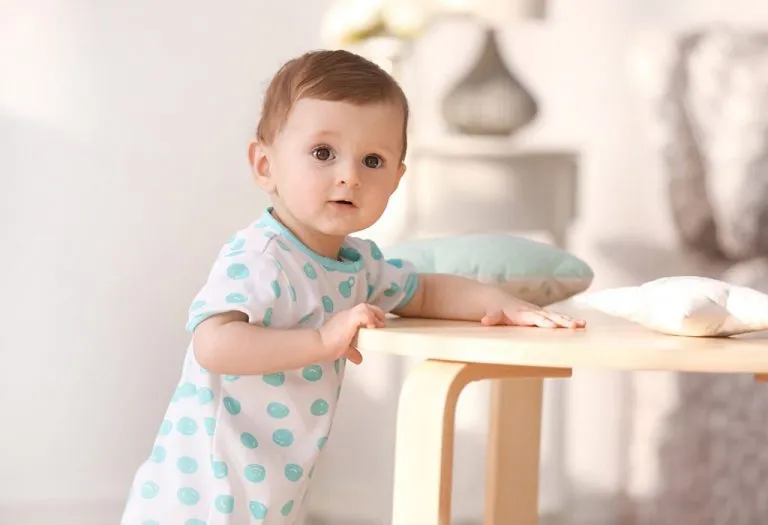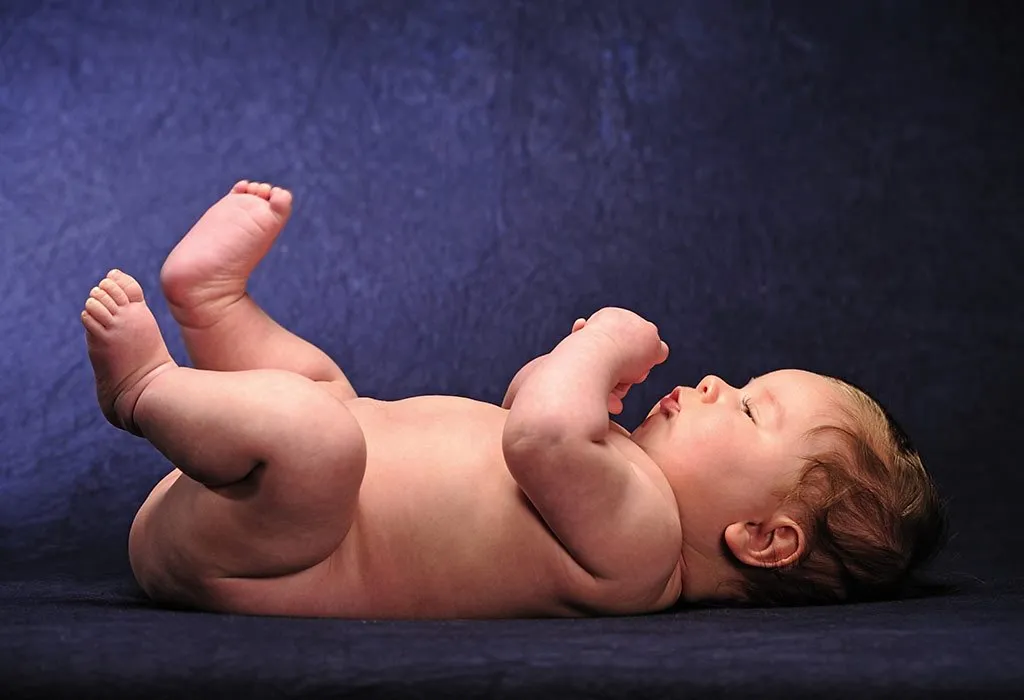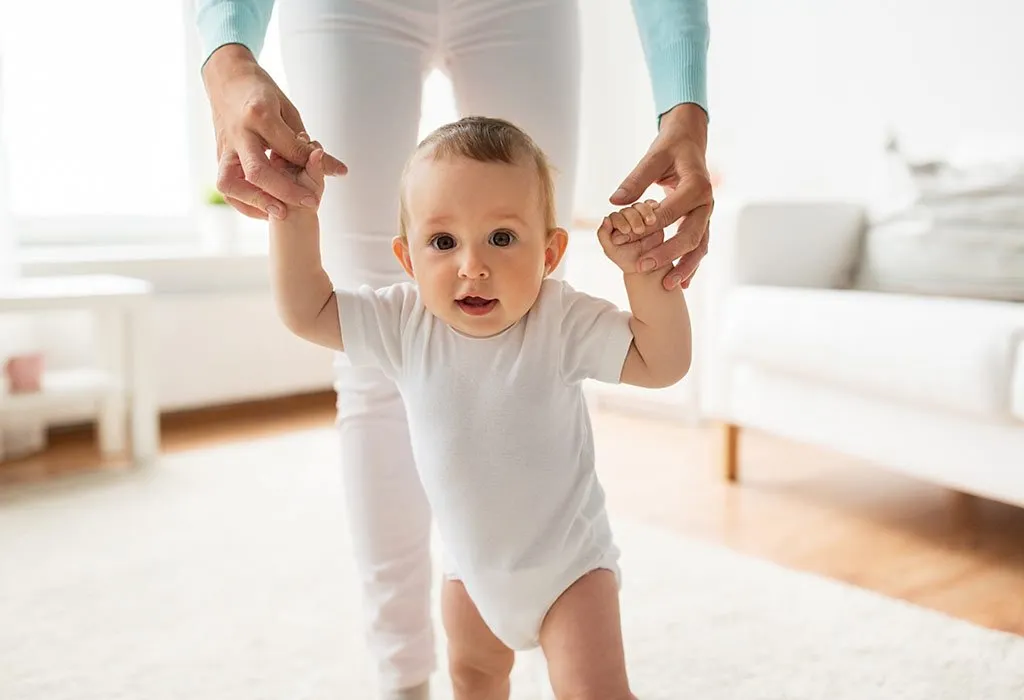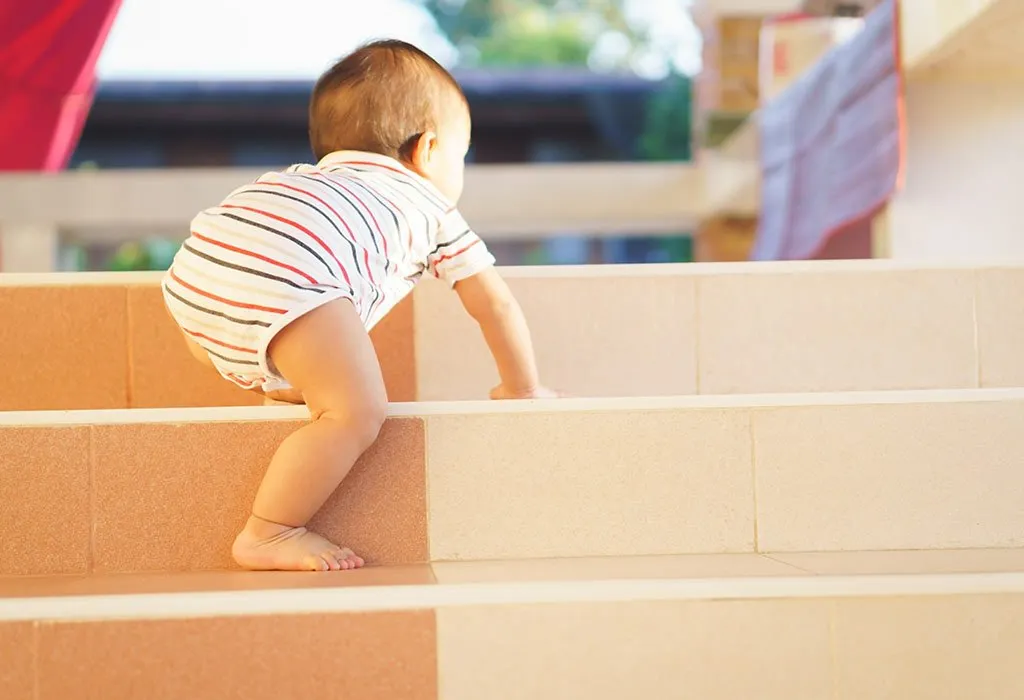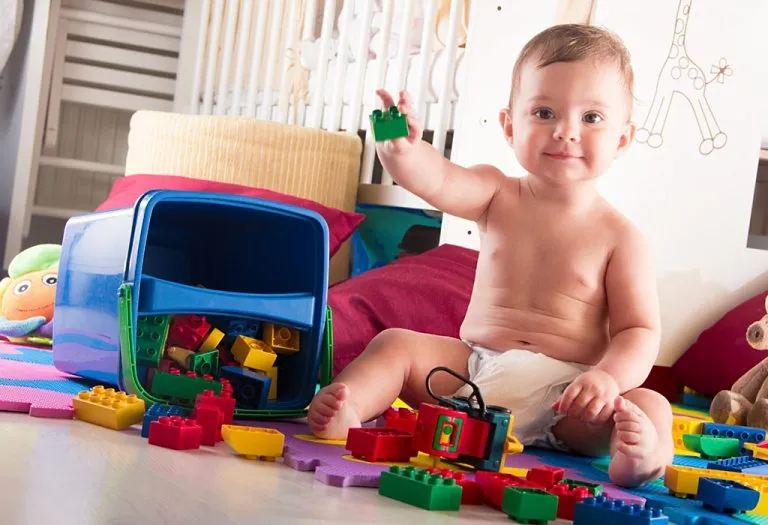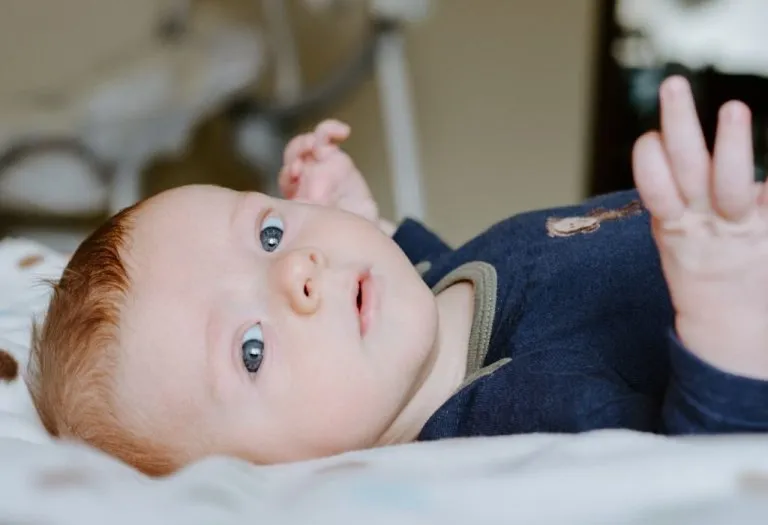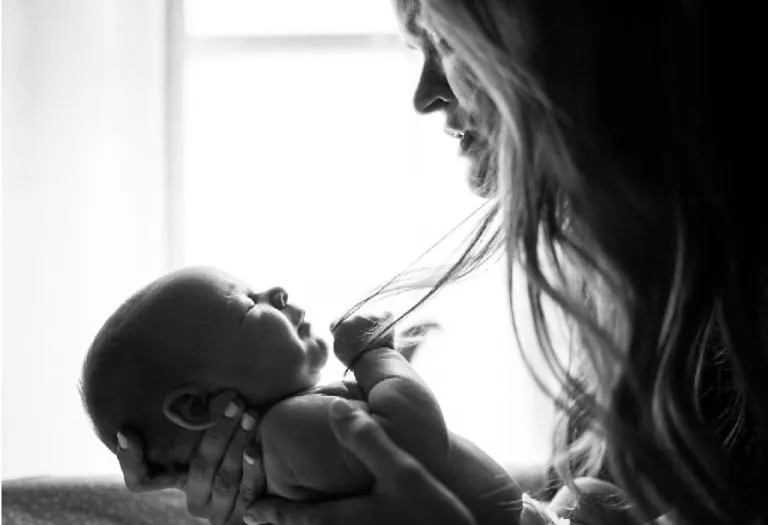When Do Babies Start Standing?

One of the proudest moments for parents is when their kids gradually grow out of their crawling phase and attempt to stand up on their own. When do babies start standing? According to the American Academy of Pediatrics, by 9 to 12 months, babies gradually build enough strength in their legs to pull to stand up on their own (1). This is an indication that they are ready for their next phase – walking. As parents, it is important that you pay attention to your child and notice any signs that he’s trying to stand up. Once he begins showing signs of standing up, you need to encourage him and provide the positive support he needs to stand up.
When Do Babies Usually Stand Up?
Babies generally attempt to stand up around the age of 9 months. A lot of parents are generally not aware when do babies stand so it is important that you keep a close watch on your child and how he’s behaving. If he’s showing signs of attempting to stand up with support, you need to be vigilant and help him out.
According to Pathways.org, a baby’s standing age is somewhere between 9 to 12 months (2). Just like everything else at that age, standing up too is a process that has different stages. Babies tend to stand up at different stages until they can get up without the need for any sort of support. As you notice this, you will see your baby’s growth incrementally until he can begin walking without the need for any support. Here is a simple timeline for you to get an idea of the standing milestone as per the Denver II Developmental Assessment (3):
- 6.5 to 8.5 months: Stand while holding some support
- 8 to 10 months: Pull to a standing position with some support
- 9 to 11.5 months: Start standing for a brief time independently
- 10.5 to 14 months: Stand independently
How Do Infants Learn to Stand?
As mentioned, infants learn to stand with the help of support and time. When they’re born, the babies display reflexes by pushing against surfaces with the help of their feet (4). It is important that you help them by supporting their head and holding them onto your lap. Babies will constantly try using their legs and while their instincts aren’t to walk, they do want to brace their legs. In the different stages of their growth, they show gradual signs such as:
Newborn to 2 months
When babies are newborn up till 2 months of age, they begin showing signs such as kicking their feet and wanting to brace their legs. Around this age, they’re still discovering their reflexes and won’t be able to walk realistically. It is important that you give them soft surfaces to feel their legs and stretch them out a little so that they can build up strength.
3 months to 6 months
Around three to six months, babies’ reflexes get replaced by their first attempts at bearing some weight. Babies generally do not have enough strength by this age so they sag at their knees, similar to a drunk person. Within a few months, however, they will possess the strength to bear some weight and will even begin bouncing up and down when their feet touch a hard surface.
By around five months, you can see the excitement in babies as you aid them in standing up. They will begin looking around for approval. Obviously, over the long-term period, they will want to get onto their feet and become upright.
Balancing babies on their feet on your thighs with support is another way to help them discover the joys of standing up. They will bounce up and down with delight as you hold them up on your feet. While they do bounce, it is important that you restrict their bouncing time to around 15-minute sessions, three times a day.
6 months to 10 months
Between the 6 to 10 months age, babies will start pulling themselves up by using furniture for support (5). If you keep them next to a sofa, they will hang on for some sort of support. This will be a big effort for them initially, as their legs are wide apart and the body will bend forward for some sort of support. It will be quite a challenge for the baby as they will grunt and try to strain themselves against the forces of gravity.
Sometimes, babies also teeter when they’re clutching the ends of the sofa and it is pretty obvious that they’re trying with all their might and their focus is entirely on one thing – to stand up.
During this phase, you can help your child out by clearing the space around from toys and sharp objects and even placing a few cushions to soften their blow if they fall down.
Falling down is a very important process for babies as they master the art of standing and eventually, walking. This process gradually begins around 6 months and as they’re standing, you’ll see them extend their arms out for support if they tilt off balance.
Within a month from this, they will learn to extend their arms forward so they can gently fall onto their front. By nine months, babies will find pulling themselves to stand up an easier process but they still won’t be able to lower themselves, falling backwards with a small bump. If you’re wondering when do babies stand with support, then you’ll find that around this time, they should be able to do so.
10 months to 12 months
At this age, babies will begin learning how to bend their knees and even sit after a standing session. However, this is a lot harder for them than we think. By the time they approach their first birthday, babies will be able to pull themselves up to stand as well as sit back down on the floor with a lot of confidence. At 12 months, they should be able to stand alone for a few moments before sitting back down.
How You Can Help Your Baby Stand?
While babies begin displaying signs of standing up, it is important that you provide them with the support they need. Here are a few ways in which you can teach a baby to stand when you see your baby trying to stand:
1. Keep their crib safe
Babies first show signs of wanting to stand up in their crib and the crib railings provide the perfect support to help stand up. They’re the perfect height and ideal to hold on to when standing up. Move the mattress to a lower setting and remove all toys so that the baby does not trip when he’s trying to stand up.
2. Help them balance on the stairs
Staircases are another place where they can learn how to stand up erect with less support. The short height of the step is perfect to help them stand up, and to initiate this, you can place your baby in a seated position and encourage him to pull himself up.
The same technique can be employed to help him crawl up and down as well. It is important that babies are supervised while they attempt these activities.
3. Provide them with safe furniture to stand up
Babies will try to use the furniture around them in order to help them stand up. It is important that you ensure that the furniture in the areas they generally use to stand up isn’t wobbly or dangerous that they can topple onto them. Furniture is very important for babies to use as support, and they will often use it to help them stand up and walk. You can also introduce walkers or bouncers for them to stand up. Just remember not to let your child depend on them as they may delay walking (6) (7).
4. Keep their toys high
By keeping a few of the baby’s favourite toys on the cushion of the couch at home, you will be able to develop enough intrigue for him to attempt to stand. As he views his toys on an elevated surface, he will try to stand up and get to them.
5. Bouncing up and down
Bouncing your baby up and down is another way to help him stand up and support himself. Keep him in front of you and hold his hands as he attempts to bounce up and down with delight.
6. Playing with push toys
Push toys are another favourite for babies who want to stand up. First, they will attempt to balance themselves with the help of these toys before attempting to walk. It is important that you supervise them, however, as they could fall down in the process of standing up and leaning against the push toy.
7. Have 15-minute walk sessions daily
Place cushions as barriers and create a path for your baby to walk. You can stand at one end of the path and clap your hands as you watch your baby attempt to walk towards you. There will be some stumbling but practising this for 15-40 minutes a day is a great way to ensure that they’re constantly practising walking. This is one of the best exercises to help baby stand.
What If There Is a Development Delay in Standing?
While most babies are fully walking by around 18 months, some babies take some time in order to begin the process. Some babies take longer to develop, and this is the same when it comes to baby standing up and walking. There are a few medical conditions too that can contribute to this, including:
- Congenital problems with orthopaedics
- Down Syndrome
- Muscular dystrophy
- Cerebral Palsy
As mentioned, by around 18 months, paediatricians expect babies to stand, walk and sit down independently.
How Long After Standing Do Babies Start Walking?
Walking is the next step after standing independently. Research suggests that babies usually start walking slowly around 2 to 2.5 months after they learn to stand without any support (8). Since every baby is unique, each baby’s progress varies. Some babies may start walking early, while some may take their sweet time. Do not rush, and be patient with your little sunshine and make beautiful memories out of this phase.
What’s Next?
So, what’s after the infant standing? Once your baby has successfully mastered the art of standing and walking, it is important that he knows how to do so without your help. Babies become very adventurous once they’re able to stand up and walk, so you need to stay alert at all times to make sure he’s not up to anything mischievous! Also, after he’s learnt how to walk and stand independently, the next step is to ensure running so you’ll have a lot on your hands to deal with.
Climbing and jumping are a few of the other activities that babies will begin discovering as well once they’ve learned how to walk.
FAQs
1. Is there anything wrong if the baby stands too early?
Every baby is unique, so their milestones may be unique, too. While some babies take their time, some may stand early. There is nothing wrong with babies standing earlier than they should. One important thing for parents to remember is not to force their children to stand up.
2. Should I be worried if my baby is 12 months old and isn’t standing?
If your baby is not standing or putting weight on their legs by their first birthday, or if you have any concerns about their development, consult your doctor about the same without any delay. For babies born early (before 37 weeks) or with conditions like Down’s syndrome, developmental milestones might be reached later than usual. Babies develop at different rates, and it’s usually not a cause for concern.
Ensure that you’re always around when babies pull to stand or when babies stand without support, and encourage them to attempt to do it on their own. With time, you will see them reacting positively to the support that you provide them and soon you’ll have your hands full trying to get them to sit in one place.
References/Resources:
1. Your Preemie’s Growth & Developmental Milestones; American Academy of Pediatrics; https://www.healthychildren.org/English/ages-stages/baby/preemie/Pages/Preemie-Milestones.aspx
2. Take a Stand! When Do Babies Stand on Their Own; Pathways.org; https://pathways.org/help-baby-stand-on-their-own/
3. Children’s Development; Thomson Delmar Learning; https://www.ccmedical.org/forms/1428352937_171971.pdf; 2007
4. Newborn Reflexes; American Academy of Pediatrics; https://www.healthychildren.org/English/ages-stages/baby/Pages/newborn-reflexes.aspx
5. Infant development: Milestones from 7 to 9 months; Mayo Clinic; https://www.mayoclinic.org/healthy-lifestyle/infant-and-toddler-health/in-depth/infant-development/art-20047086
6. How to keep your baby or toddler active; NHS; https://www.nhs.uk/conditions/baby/babys-development/play-and-learning/keep-baby-or-toddler-active/
7. Baby Walkers: A Dangerous Choice; American Academy of Pediatrics; https://www.healthychildren.org/English/safety-prevention/at-home/Pages/Baby-Walkers-A-Dangerous-Choice.aspx
8. Ertem. I. O, et al.; Similarities and differences in child development from birth to age 3 years by sex and across four countries: a cross-sectional, observational study; The Lanet Global Health; https://www.thelancet.com/journals/langlo/article/PIIS2214-109X(18)30003-2/fulltext; March 2018
Also Read:
Baby Clapping Milestone
Baby Speaking Milestone
When Do Babies Start Hearing?
When Do Newborn Baby Start Seeing?
Was This Article Helpful?
Parenting is a huge responsibility, for you as a caregiver, but also for us as a parenting content platform. We understand that and take our responsibility of creating credible content seriously. FirstCry Parenting articles are written and published only after extensive research using factually sound references to deliver quality content that is accurate, validated by experts, and completely reliable. To understand how we go about creating content that is credible, read our editorial policy here.






